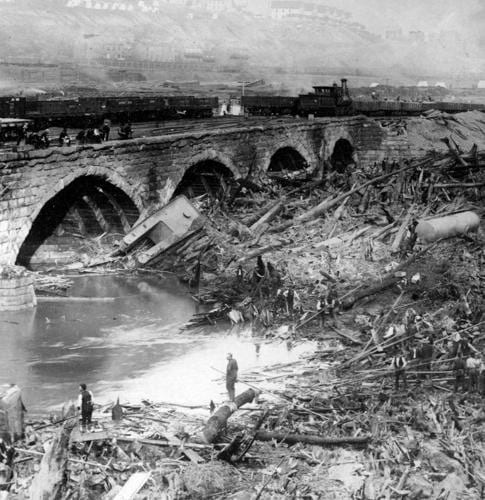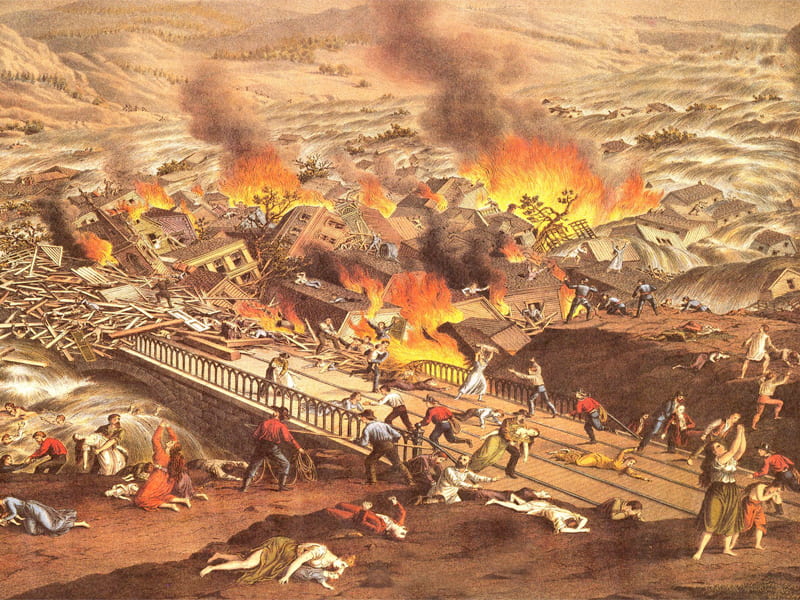The immediate aftermath of the Johnstown Flood was a horrifying sight of death and destruction. The flood waters that tore through the valley leading to Johnstown destroyed any infrastructure they came across, including the Conemaugh Viaduct, which provided rail access to Pittsburgh from Central Pennsylvania. The town of Johnstown itself resembled the city of Hiroshima after the atomic blast. Thousands of lives were snuffed out, picked up by the water and piled against the Stone Bridge. This bridge actually survived the flood, and served as the focal point for the next disaster to be suffered by the town: fire.

In a cruelly ironic twist, the town destroyed by a flood would almost immediately afterwards be consumed by fire. An estimated 30 acres of debris was piled behind Stone Bridge, a hellish amalgamation of rolling stock, barbed wire, buildings, bodies, and flammable liquids such as kerosene. This mass soon caught fire, and burned relentlessly.

For the town, the most immediate need was the restoration of order to the town and the removal of the dead. In the latter case, several temporary morgues were set up and staffed by professional undertakers who did their best to identify and properly dispose of the many bodies in the area. In the former case, the townsfolk often took the law into their own hands. Looters and other criminals were often hung or shot without a fair trial, as the suffering town simply did not have enough time to properly institute justice. In the coming months, Johnstown would soon become a focal point for one of the first large relief efforts in America.

Until 1889, all of America’s efforts were on expanding westward, staking lands and setting up homesteads as fast as the government would allow. Following the Johnstown Flood, the nation’s efforts reversed, and all eyes were on fulfilling a truly awe-inspiring order for humanitarian aid. Almost immediately, trains from Pittsburgh were dispatched with food and clothes. The Governor of Pennsylvania at the time, James Beaver (a familiar name to us here at Penn State), mobilized the Pennsylvania Militia to provide support. Thousands of workmen from the Pennsylvania Railroad were put to work rebuilding the track damaged by the flood, which was rebuilt in just over 2-weeks. Prefabricated homes used by homesteaders were shipped to Johnstown to provide shelter for residents (the tale of the mail-order home in the early 20th century is an interesting rabbit hole to get into). The American Red Cross, led by Clara Barton, brought thousands of volunteers to assist in relief efforts.
When all was said and done, the community of Johnstown was affected forever. over 2,200 people had perished in the flood, and almost half a billion dollars in property had been damaged. Much of the blame for the disaster rested solely on the South Fork Fishing and Hunting Club, which caused the disaster by not maintaining their dam correctly. Unfortunately, this was still 19th-century America, and the shrewd members of the club – the Carnegies and the Fricks, took many steps to avoid paying money in damages caused by the flood. Today, the former clubhouse stands as a museum, as a constant reminder of the death and destruction brought about by the club’s owners.
Being able to read part II of this story on your blog was, just like part I, very interesting. I found it almost insane how I had never heard of this event before reading your blog. How could an event with such destruction and relative closeness to me never have reached my ears? I will definitely be checking out the Wikipedia article on mail-order houses because just by going off of the name, I have many questions. Very fascinating post overall.